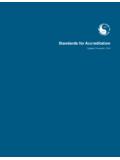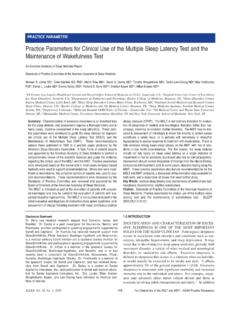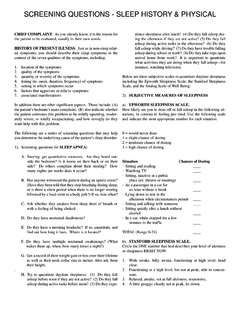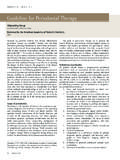Transcription of Pharmacologic Treatment of Insomnia - American Academy …
1 307 journal of Clinical Sleep Medicine, Vol. 13, No. 2, 2017 Introduction: The purpose of this guideline is to establish clinical practice recommendations for the Pharmacologic Treatment of chronic Insomnia in adults, when such Treatment is clinically indicated. Unlike previous meta-analyses, which focused on broad classes of drugs, this guideline focuses on individual drugs commonly used to treat Insomnia . It includes drugs that are FDA-approved for the Treatment of Insomnia , as well as several drugs commonly used to treat Insomnia without an FDA indication for this condition. This guideline should be used in conjunction with other AASM guidelines on the evaluation and Treatment of chronic Insomnia in : The American Academy of Sleep Medicine commissioned a task force of four experts in sleep medicine. A systematic review was conducted to identify randomized controlled trials, and the Grading of Recommendations Assessment, Development, and Evaluation (GRADE) process was used to assess the evidence.
2 The task force developed recommendations and assigned strengths based on the quality of evidence, the balance of benefits and harms, and patient values and preferences. Literature reviews are provided for those Pharmacologic agents for which sufficient evidence was available to establish recommendations. The AASM Board of Directors approved the final : The following recommendations are intended as a guideline for clinicians in choosing a specific pharmacological agent for Treatment of chronic Insomnia in adults, when such Treatment is indicated. Under GRADE, a STRONG recommendation is one that clinicians should, under most circumstances, follow. A WEAK recommendation reflects a lower degree of certainty in the outcome and appropriateness of the patient-care strategy for all patients, but should not be construed as an indication of ineffectiveness. GRADE recommendation strengths do not refer to the magnitude of Treatment effects in a particular patient, but rather, to the strength of evidence in published data.
3 Downgrading the quality of evidence for these treatments is predictable in GRADE, due to the funding source for most pharmacological clinical trials and the attendant risk of publication bias; the relatively small number of eligible trials for each individual agent; and the observed heterogeneity in the data. The ultimate judgment regarding propriety of any specific care must be made by the clinician in light of the individual circumstances presented by the patient, available diagnostic tools, accessible Treatment options, and We suggest that clinicians use suvorexant as a Treatment for sleep maintenance Insomnia (versus no Treatment ) in adults. (WEAK)2. We suggest that clinicians use eszopiclone as a Treatment for sleep onset and sleep maintenance Insomnia (versus no Treatment ) in adults. (WEAK)3. We suggest that clinicians use zaleplon as a Treatment for sleep onset Insomnia (versus no Treatment ) in adults. (WEAK)4. We suggest that clinicians use zolpidem as a Treatment for sleep onset and sleep maintenance Insomnia (versus no Treatment ) in adults.
4 (WEAK)5. We suggest that clinicians use triazolam as a Treatment for sleep onset Insomnia (versus no Treatment ) in adults. (WEAK)6. We suggest that clinicians use temazepam as a Treatment for sleep onset and sleep maintenance Insomnia (versus no Treatment ) in adults. (WEAK)7. We suggest that clinicians use ramelteon as a Treatment for sleep onset Insomnia (versus no Treatment ) in adults. (WEAK)8. We suggest that clinicians use doxepin as a Treatment for sleep maintenance Insomnia (versus no Treatment ) in adults. (WEAK)9. We suggest that clinicians not use trazodone as a Treatment for sleep onset or sleep maintenance Insomnia (versus no Treatment ) in adults. (WEAK)10. We suggest that clinicians not use tiagabine as a Treatment for sleep onset or sleep maintenance Insomnia (versus no Treatment ) in adults. (WEAK)11. We suggest that clinicians not use diphenhydramine as a Treatment for sleep onset and sleep maintenance Insomnia (versus no Treatment ) in adults.
5 (WEAK)12. We suggest that clinicians not use melatonin as a Treatment for sleep onset or sleep maintenance Insomnia (versus no Treatment ) in adults. (WEAK)13. We suggest that clinicians not use tryptophan as a Treatment for sleep onset or sleep maintenance Insomnia (versus no Treatment ) in adults. (WEAK)14. We suggest that clinicians not use valerian as a Treatment for sleep onset or sleep maintenance Insomnia (versus no Treatment ) in adults. (WEAK)Keywords: Insomnia , Treatment , Pharmacologic , guidelineCitation: Sateia MJ, Buysse DJ, Krystal AD, Neubauer DN, Heald JL. Clinical practice guideline for the Pharmacologic Treatment of chronic Insomnia in adults: an American Academy of Sleep Medicine clinical practice guideline. J Clin Sleep Med. 2017;13(2):307 ARTICLESC linical Practice Guideline for the Pharmacologic Treatment of Chronic Insomnia in Adults: An American Academy of Sleep Medicine Clinical Practice GuidelineMichael J. Sateia, MD1; Daniel J.
6 Buysse, MD2; Andrew D. Krystal, MD, MS3; David N. Neubauer, MD4; Jonathan L. Heald, MA51 Geisel School of Medicine at Dartmouth, Hanover, NH; 2 University of Pittsburgh School of Medicine, Pittsburgh, PA; 3 University of California, San Francisco, San Francisco, CA; 4 Johns Hopkins University School of Medicine, Baltimore, MD; 5 American Academy of Sleep Medicine, Darien, ILpii: jc-00382-16 of Clinical Sleep Medicine, Vol. 13, No. 2, 2017MJ Sateia, DJ Buysse, AD Krystal, et al. Clinical Practice Guideline: InsomniaTABLE OF CONTENTSI ntroduction 308 Background 309 Methodology 312 Clinical Practice Recommendations 315 Orexin receptor agonists Suvorexant 317 Benzodiazepine receptor agonists Eszopiclone 318 Zaleplon 321 Zolpidem 323 Benzodiazepines Triazolam 326Te m a z e p a m 327 Melatonin agonists Ramelteon 329 Heterocyclics Doxepin 331 Trazodone 332 Anticonvulsants Tiagabine 333 Over-the-counter preparations Diphenhydramine 334 Melatonin 335L-tryptophan 337 Valerian 338 Literature Reviews 338 Estazolam 338 Quazepam 339 Flurazepam 340 Oxazepam 341 Quetiapine 341 Gabapentin 341 Paroxetine 341 Trimipramine 342 Discussion and Future Directions 342 INTRODUCTIONAimsThis clinical practice guideline was initiated at the request of the Board of Directors of the American Academy of Sleep Medicine (AASM), who also reviewed this document and provided feedback.
7 No formal clinical practice guidelines for the pharmacological Treatment of Insomnia have previously been issued by the AASM, despite the fact that this remains, by far, the most common approach to therapy, after Treatment of comorbidities. Pharmacotherapy is one of two major ap-proaches to Treatment , the alternative being cognitive behav-ioral therapies for Insomnia (CBT-I), already identified as a standard of Treatment . This paper does not directly address the relative benefits of these two approaches. Rather, the conclu-sions and recommendations regarding pharmacotherapy must be considered within the context of specific Treatment goals, comorbidities, prior Treatment responses, availability, safety, patient preference and cost considerations. Despite the clearly favorable benefit to risk ratio of CBT-I, not all patients with an Insomnia disorder can and will derive benefit from this treat-ment alone. This failure may result from inability to access such Treatment (due to availability, cost restraints, etc.)
8 , inabil-ity or unwillingness to participate in the therapy, or Treatment non-responsiveness. Thus, pharmacotherapy, alone or in com-bination with CBT-I, must continue to be considered a part of the therapeutic armamentarium, as it currently is for perhaps 25% of the Unfortunately, many individuals use medications or substances ( over-the-counter sleep aids or alcohol) which are not demonstrated to be effective in manag-ing Insomnia and/or have significant potential for harm. For the estimated to 7% of individuals receiving prescrip-tion medication for sleep disturbance,2 4 significant knowledge gaps and anxieties about the proper usage of these agents ex-ists among the paper includes a systematic review and meta-analyses which provides the basis of the initial AASM clinical practice guideline for pharmacological management of Insomnia . The aims of the present analysis are: (1) to determine the efficacy of individual prescription and non-prescription medications for Treatment of Insomnia ; (2) to assess the efficacy of indi-vidual medications for specific sleep complaints ( difficulty initiating sleep/difficulty maintaining sleep); (3) to evaluate the potential for adverse effects of these drugs; (4) to consider the evidence concerning efficacy and adverse effects in delineat-ing evidence-based guidelines for the use of pharmacotherapy in the management of chronic Insomnia ; and (5) to offer rec-ommendations for optimizing quality and uniformity of future clinical practice guideline is intended to serve as one component in an ongoing assessment of the individual patient with Insomnia .
9 As discussed elsewhere,5 7 a comprehensive initial evaluation should include a detailed history of sleep complaints, medical and psychiatric history, and medication/substance use. These factors, together with patient preferences and Treatment availability, should be used to select specific treatments for specific patients. This clinical practice guide-line is not intended to help clinicians determine which patient is appropriate for pharmacotherapy. Rather, it is intended to provide recommendations regarding specific Insomnia drugs once the decision has been made to use pharmacotherapy. This guideline is also not intended to recommend one drug over an-other. Very few comparative efficacy studies have been con-ducted among these agents. Rather, the guideline provides a recommendation and evidence base for each individual drug. The selection of a particular drug should rest on the evidence summarized here, as well as additional patient-level factors, such as the optimal pharmacokinetic profile, assessments of benefits versus harms, and past Treatment guideline should be used in conjunction with other AASM guidelines on the evaluation and Treatment of chronic Insomnia .
10 These guidelines indicate that CBT-I is a standard of Treatment and that such Treatment carries a significantly fa-vorable benefit:risk ratio. Therefore, based on these guidelines, all patients with chronic Insomnia should receive CBT-I as a primary intervention. Medications for chronic Insomnia dis-order should be considered mainly in patients who are unable 309 journal of Clinical Sleep Medicine, Vol. 13, No. 2, 2017MJ Sateia, DJ Buysse, AD Krystal, et al. Clinical Practice Guideline: Insomniato participate in CBT-I, who still have symptoms despite par-ticipation in such treatments, or, in select cases, as a temporary adjunct to Guidelines and Practice ParametersThe AASM has issued several guidelines, reviews, and prac-tice parameters related to the assessment and management of Insomnia . A 2000 review and practice parameter paper ad-dressed the comprehensive evaluation of chronic ,6 Non-pharmacological management of Insomnia has been the subject of two practice parameter 11 No formal, evidence-based standards of practice for pharmacological Treatment of Insomnia have been published, although clinical guidelines addressing this topic have been issued by various groups.










